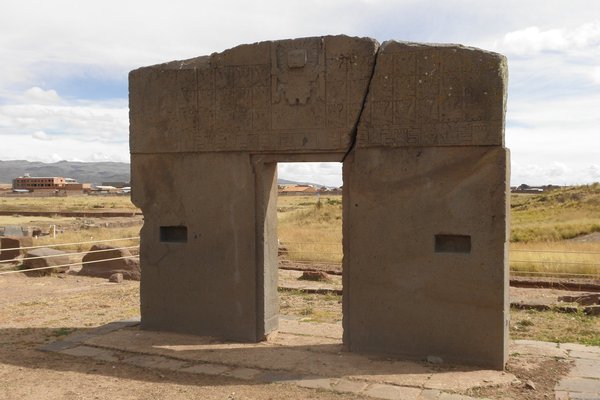Bolivia
Tiwanaku
“Tiwanaku: Spiritual and Political Centre of the Tiwanaku Culture” comprises the ruins of the capital of an important and distinct pre-Hispanic empire in the Andes.
The ancient city was mostly built of adobe, especially the residential buildings that have now faded away. For ceremonial and administrative architecture, lithic material was used. Notable remaining monuments include the Akapana (the major temple, a stepped pyramid), a semi-underground temple (with monolithic stelae and heads (clavas) built in the walls), and the Kalasasaya (an open temple built on a platform; it includes stelae and the Gate of the Sun frieze).
Community Perspective: Tiwanaku is usually visited as a day trip from La Paz. In addition to the architectural ruins, there are also two on-site museums that are worth seeing. Most reviewers find the site overall a bit underwhelming and it does not take much time to visit.
Site Info
Official Information
- Full Name
- Tiwanaku: Spiritual and Political Centre of the Tiwanaku Culture (ID: 567)
- Country
- Bolivia
- Status
-
Inscribed 2000
Site history
History of Tiwanaku
- 2000: Inscribed
- Inscribed
- 1998: Deferred
- Bureau - for more info re protection/management (of undoubted siginifance however)
- 1991: Referred
- Bureau - better boundaries. Help to be given to Bolivia
- Type
- Cultural
- Criteria
- iii
- iv
Links
- UNESCO
- whc.unesco.org
- Official
-
- tiwanaku.gob.bo — Complejo Arqueológico
- Related
-
- jqjacobs.net — Link
All Links
UNESCO.org
- whc.unesco.org — whc.unesco.org/
Official Website
- tiwanaku.gob.bo — Complejo Arqueológico
Related Resources
- jqjacobs.net — Link
News Article
- Sept. 20, 2019 abcnews.go.com — Pre-Hispanic vessels over 1,400 years old have been found in the center of Bolivia's Tiwanaku ruins
- April 2, 2015 latino.foxnews.com — Bolivia detects buried pyramid at Tiahuanaco site
- Oct. 21, 2009 wanderlust.co.uk — Akapana "renovation" threatens site's World Heritage status
Community Information
- Community Category
- Archaeological site: Pre-Columbian
Travel Information
Exact locations inscribed twice (or more)
Recent Connections
-
Erich von Däniken
"In the late 1960s, writer Erich von Da… -
Foreigner prices
Foreigners 100 bolivianos, locals 15 bo… -
Inscribed at third attempt or more
Ref 1991, Def 1998, Ins 2000
Connections of Tiwanaku
- Individual People
-
-
Visited by Alexander von Humboldt on his travels
1804 -
Erich von Däniken
"In the late 1960s, writer Erich von Daniken concluded from his "research" that aliens set up a base at Tiwanaku and erected the great monuments using their extraterrestrial technology. He used as evidence a bizarre biblical interpretation that the prophet Ezekiel had been abducted by these same cosmic beings."See www.penn.museum
-
Max Uhle
In 1892 Uhle "published "The Ruins of Tiahuanaco in the Highlands of Ancient Peru," .... This extensive work is considered the first in depth scientific account of the ancient site of Tiwanaku Bolivia.
-
- Geography
-
-
Highest cultural WHS
3,900 m -
Andes
"The city of Tiwanaku was the capital of a prehispanic empire that dominated a large area of the southern Andes" (brief description)
-
- Trivia
-
-
Dubbed as another WHS
"The Baalbek of the New World" by American Archaeologist Ephram George Squier in 1877. Chapter XV of "Incidents of Travel and Exploration in the Land of the Incas". Also: the "American Stonehenge" (see link).See www.penn.museum
-
On Banknotes
200 Bolivianos; 2005
-
- History
-
-
Pre-Inca cultures
Tiwanaku -
Located in a Former Capital
Tiwanaku Empire, 300-1000 -
Qhapaq Nan (Inca)
-
Archaeological 'Type Sites'
Tiwanaku CultureSee www.indiana.edu
-
- World Heritage Process
-
-
Reconstruction regarded as unsatisfactory
Akapana Pyramid : around 2009, there was a controversial attempt to "restore" the pyramid using adobe bricks instead of the original stone, which drew international criticism and raised concerns from UNESCO about the erosion of the property's authenticity and even the risk of collapse.See www.nbcnews.com
-
Inscribed at third attempt or more
Ref 1991, Def 1998, Ins 2000 -
Exact locations inscribed twice (or more)
Also part of Qhapaq Nan
-
- Human Activity
-
-
Irrigation and drainage
-
Mummies
Preservation, use, and reconfiguration of mummy bundles and skeletal remains -
Language isolate
It is assumed the language used by the Tiwanaku was Puquina, a language isolate that used to be spoken around Lake Titicaca.
-
- Constructions
-
-
Tunnels
At the Akapana Pyramide -
Passage of the Sun
-
Stelae
several -
Pyramids
The Akapana PyramidSee wikimapia.org
-
Cemeteries
Laka Kollu
-
- WHS on Other Lists
-
-
U.S. Ambassadors Fund
Preventive Conservation of the Archaeological Collection at Tiwanaku (2011)
-
- Timeline
-
-
Built in the 6th century
AB: around 550 became capital of a vast empire
-
- Science and Technology
-
-
Astronomy and Astrology
"Researchers speculate that the Akapana temple may also have been used as an astronomical observatory. It was constructed so that it was aligned with the peak of Quimsachata, providing a view of the rotation of the Milky Way from the southern pole.[29] Other temples like Kalasasaya are positioned to provide optimal views of the sunrise on the Equinox, Summer Solstice, and Winter Solstice. Although the symbolic and functional value of these monuments can only be speculated upon, the Tiwanaku were able to study and interpret the positions of the sun, moon, Milky Way and other celestial bodies well enough to give them a significant role in their architecture." (wiki) -
Excavated by American Universities
Chicago University
-
- Visiting conditions
-
-
Foreigner prices
Foreigners 100 bolivianos, locals 15 bolivianos.
-
- WHS Names
-
-
Epic Subtitles
Spiritual and Political Centre of the Tiwanaku Culture
-
News
- abcnews.go.com 09/20/2019
- Pre-Hispanic vessels over 1,400 ye…
- latino.foxnews.com 04/02/2015
- Bolivia detects buried pyramid at …
- wanderlust.co.uk 10/21/2009
- Akapana "renovation" threatens sit…
Recent Visitors
Visitors of Tiwanaku
- Alberto Rodriguez Gutierrez
- Alejandro Lau
- Ammon Watkins
- Ana
- Andrew0181
- Argo
- Artur Anuszewski
- Atila Ege
- Bamse
- basementonline
- Bill Maurmann
- Bram de Bruin
- Carlos Sotelo
- Christoph
- Christravelblog
- CynthiaSam
- czesioszpachelka
- Daniela Hohmann
- dave wood
- Dennis Nicklaus
- Dirk-pieter
- Els Slots
- emvcaest
- Erik Jelinek
- Fan Yibo
- Fernweh
- Francky D'Hoop
- Gilles
- Harald T.
- Harry Mitsidis
- headventure
- hotpickle
- Hughes1920
- Hunstow
- Iain Jackson
- IreneKD
- Jacob Otten
- janis
- Jarek Pokrzywnicki
- Jens
- J_neveryes
- João Aender
- Joel on the Road
- Joyce van Soest
- Karito Vies
- Kurt Lauer
- Loic Pedras
- Luis Filipe Gaspar
- Lukasz Palczewski
- Maciej Gil
- Malgorzata Kopczynska
- marcel staron
- maryhattie
- M.HATADA
- Michael Ayers
- Michael Novins
- Milan Jirasek
- MMM
- Monica Tasciotti
- Morodhi
- nan
- natlefebvre@hotmail.
- Nihal Ege
- PabloNorte
- Patrik
- Paul Schofield
- Pchxiao
- Philipp Leu
- Pink Bunny
- Randi Thomsen
- Reza
- Roman Bruehwiler
- Sandmann15
- Sclowitz
- Sergio Arjona
- Shandos Cleaver
- sibariam
- Solivagant
- Squiffy
- Ssong.x
- Stanislaw Warwas
- Sutul
- Svein Elias
- Tevity
- Tim Allen
- Timonator
- Timothy C Easton
- Walter
- Weecheng
- Xiquinho Silva
- zfish
- Zoë Sheng
Community Reviews
Show full reviews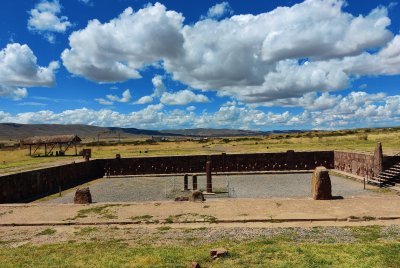
There's just enough left of the Tiwanaku site that I was able to get a decent appreciation for this ancient culture. The museums are very well done, featuring several impressive stone sculptures. The highlight of the museums is the Bennett Monolith, an amazing 7-meter tall statue in excellent condition after over 2000 years. It survived the Spanish by being buried until rediscovered in the 1930s. Out in the main site, we started our tour at the Akapana Pyramid which gives a nice overview of the site. While the Sun Gate on the Kalasasaya courtyard is probably the most famous artifact here, I really liked the semi-subterranean temple. This sunken area is where the Bennett Monolith was found. The walls of the temple feature rows of numerous skull sculptures, some more like a human skull and others are more stylized.
The auxilliary site of Puma Punku is also worth a short visit. There isn't a lot to see there, but it is worth checking out the jumble of remaining building stones and walking around the perimeter.
I joined an organized tour from La Paz that was pretty cheap (about $US 13), and had a very good guide who did a nice job of explaining the site. Overall, I enjoyed learning about another impressive pre-Columbian culture.
Keep reading 0 comments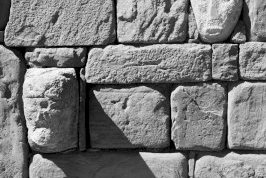
Tiwanaku is a site with fascinating elements, but the sum of those elements do not result in a fascinating site.
The individual elements, such as the Gate of the Sun, the monoliths, and the heads in the semi-subterranean temple (photo) are striking artifacts. For some visitors, the Gate of the Sun, with a crack in its lintel that adds to its mysterious allure, alone may be worth the price of the admission. However, other than the few interesting elements still standing (or fallen), the site is monotonous.
Additionally, the site is heavily reconstructed with non-original materials. The walls of the Kalasasaya - the platform on which the Gate of the Sun sits - is not original with the exception of the taller stone pillars. Old drawings and photos of Tiwanaku show the stone pillars standing freely, akin to the ancient stones of Avebury. It is very likely that there were indeed stone walls between these pillars, but those stones were long ago taken from the site to be used for constructing buildings elsewhere, e.g., the church in the nearby village.
The Akapana "pyramid" is also mostly a reconstruction. Indeed, Akapana was never quite completed in antiquity and looked more like a natural hill until recently (A Spanish chronicler said of Tiwanaku, "They build their monuments as if their intent was never to finish them.")
There are two museums at Tiwanaku. One of the museums contain artifacts such as the artificially elongated skulls of the Tiwanku …
Keep reading 0 comments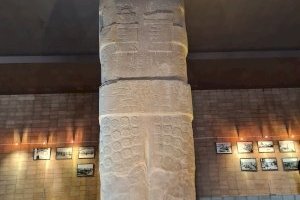
I find it hard to review the sites independant from the bad travel experience I had. Therefore first of all the circumstances and second of all the experience on site. I tried to visit Tiwuanaku twice (!) from La Paz by public transport. The first time failed unfortunately. After a nice walk over La Paz cemetery I reached the closeby spot where trufis go to Tiwuanaku when full. It was the Friday before the La Paz Anniversary at about 9 a.m. Some other tourists and locals waited there slready half an hour. The office was closed. After nothing happened for another 30 minutes we decieded to go up to El Alto Terminal Interprovincial. Big mistake not to take the efficient téleferico but a taxi. The taxi driver kicked us out as soon as reaching El Alto as he didn't knew the way to the terminal. The Uber driver afterwards got stuck in the huge markets and some parades in El Alto. Finally we took the téleferico and reached the terminal at about noon. We decided that it's too late to visit the one hour distanced Tiwuanaku now. One week later we returned to the cementary Trufi office at 08:30 a.m. and it took until 10 a.m. until the trufi was full. Not to mention that I was annoyed by the fact that they explained that the week before there was a reunion that's why they didn't operate but normally they go every day. Without apologizing of course. Then we had …
Keep reading 0 comments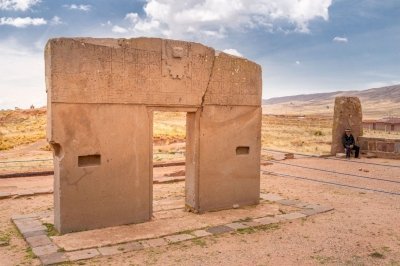
Tiwanaku is an easy day trip from La Paz. It takes approximate 2 hours by car from La Paz to Tiwanaku. I highly recommend to either hire a car yourself drive or take other private transport. A car with driver should not cost more as 80 USD for the day. Personally, I prefer to go private as I have more flexibility to stop at places where I want to make a photo or just look around. It takes approximate 2-3 hours to explore the archeological remains of Tiwanaku, an hour for the two museums and another hour for the nearby Pumapunku excavations. I left my hotel in La Paz at 9:30AM and was back well before dinner time, which is late in Bolivia.
The Tiwanaku ticket gives access to two separate entrances; the largest site is Tiwanaku and the smaller is Pumapunku just a kilometer away. The museums are located at the Tiwanaku site which I advise to visit first to learn about the Tiwanaku Empire. There are some interesting statues, steles, pottery, and other artifacts on display. The Bolivian government is expanding the museums collecting more artifacts from the empire in one place which is a good thing to see them together.
I enjoyed the sites, but I must admit that you can walk through it quite fast. Akapana pyramid was good. It gives from the top a good overview of the site as well. At various places there are foundation stones with pretty nice carvings but …
Keep reading 0 comments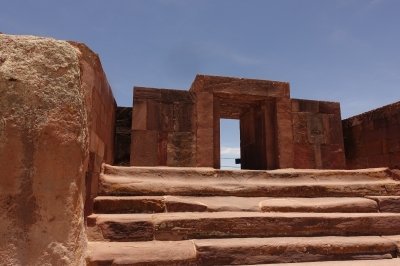
On what used to be close to the Southern shore of Lake Titicaca, you will find the ruins of Tiwanaku. Billed by some Bolivians as Bolivian Tikal, you will find a small pre colombian and pre inka archeological site whose history reaches back to 1500 BCE.
For a long time the area was very fertile. But climate change and deforestation severely hit. Nowadays, the shores of Lake Titicaca are a distant 10km away and the area is covered by strubs and bushes.
The site shows some nice stone works. The original pyramid is gone and hard to imagine based on the ruins that remain. As is often the case with pre columbian ruins the Spanish removed stones and used them for buildings in the nearby village, specifically the Spanish colonial church.
On site several museums display excavation finds. The big stela is quite impressive. In the end, this is a fairly simple site and not much to dial home about.
Getting There
From La Paz you can do this on your own via colectivo. I can't confirm all the details of the how to, but I can confirm that there were colectivos waiting in Tiwanaku to take you back to La Paz.
Due to being a bit time stressed and the organized tours being fairly cheap (below 20 USD) I opted for an organized tour. As is often the case most agencies seem to be selling the same tour. I booked via Diana Tours due to their …
Keep reading 0 comments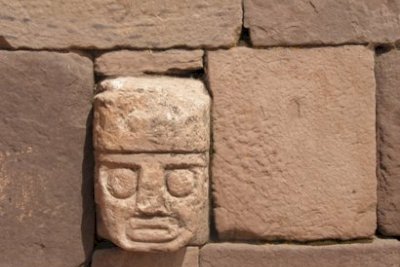
Tiwanaku lies 72km to the west of La Paz. It's a very fine trip to get out there: you'll pass the buzzing suburb of El Alto and the quintessential Altiplano landscape with lama's, indigenous Aymara women in traditional dress, and mountain vistas.
The Tiwanaku site consists of 2 museums and an archeological site. The entrance fee for foreigners is 80 bolivianos (8 EUR), which gives you access to both museums and the site. The ceramics museum has a lot of pottery made by the Tiwanaku, as well as by their predecessors and the Inca. The "Lithic Museum" still only holds one piece - the Pachamama or Bennett Stele. It's a grand piece of work, a 7 meters high monolith, transported here from the center of La Paz where it had stood for years. It did not look as if other prominent findings were soon to join it in the "museum". Further development of both the museum and the archaeological site seems to have come to a stop. Our guide told us that there is a conflict between the local indigenous people and the Ministry of Culture on how to proceed.
The archeological site is spread out over a vast area, without many obvious highlights. The "pyramid" is just like a small hill. They hope to have it restored completely in 5 years, but that doesn't seem likely to me.
Having visited so many archeological sites in Peru, for me it was interesting to see the links between …
Keep reading 0 comments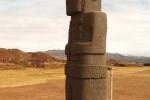
Tiwanaku (Tiahuanaco) is a complex of buildings, temples and a pyramid from pre-Inca times and is therefore Bolivia's most important archeological site.
The site consists of two museums and the archeological grounds with the buildings. One museum hosts mostly ceramic artifacts and the other one only hosted one sculpture by the time I visited it (June 2008). More artifacts and sculptures will be brought from the archeological site to the museums in the near future for preservation.
The archeological site has a piramide that covers more square meters than the one from Geops in Egypt, but is less tall. Total excavation is to be done in about 7 years. Interesting are the way the bricks are placed on the buildings (just like the Inca's used to do it later on), the ear-shaped loudspeaker, the interesting and very detailed carving on the sculptures and the faces on the wall of the Semi-subterranean Temple.
Keep reading 0 comments
